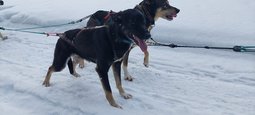
Alaskan Husky
The history of the Alaskan Husky basically starts with the history of all nordic breeds, as the Alaskan is a mix-breed between many of those breeds. More than 4000 years ago, different tribes all over the northern hemisphere used dogs for pulling material on long distances and on hunting trip in the waste arctic areas. Following those tribes, some breeds and sub-breeds came from Siberia to Alaska and North-America and a genetical exchange started.
Indians and Eskimos always used dogs, not only for pulling and hunting, but also for cleaning up around their yards by eating all leftovers from human food, and as playing friends for their children. A family normally had around 10 dogs, some rich ones even up to 100.
Up in the northern areas, a big sized, strong type of dog was dominating, more in the South they were smaller and lighter built. A mix of both types was the start of the Alaskan as it is today.
The heavy built polardog type still exists today in the breed of Greenlanddogs or some small sub-breeds from Kamtschatka and other areas. The Indian dog was more looking like a wolf, longer legs, lighter built body with a long back, to be able to run also on longer distances.
All those dogs were living free, but always following their humans and their rules. If a dog was "not good enough", it was castrated or eliminated, which resulted after many generations of strict breeding selection in a very social, freindly to humans, hard working and easy to handle dog breed with very simple needs to survive.
A complete change in breeding system arrived during the Goldrush period in Alaska when white men used every kind of animal that could pull their material to the gold fields in Yukon and Alaska. All kind of dogs were used for breeding, every big breed, every mix, even aggresive ones were used for breeding to supply the gold diggers with enough pulling dogs. Only the toughest survived those times. For post services they used also some lighter breeds such as Irish or Gordon Setters, labradors and other bird-dogs.
During those times, the hobby of many white men was every kind of competition with money-prizes. This is maybe the reason, why the Alaskan Husky survived as "breed", even though in recent times, railways, airplanes and scooters took over completely the earlier job of the sleddog.
In 1908, the first big sleddog race took place in Nome, 670 km long "All Alaska Sweepstake". In the first year, normal standard pulling breeds were used, but soon they realised, that those were not fast and challenging enough. In the next years, many crossings with Bird-dogs were used or some dogs even imported especially for this race. Only a dog who made the whole distance of the race had the right to be called "Alaskan". In 1925, the Alaskans could proof what they were able to do, when several teams brought vaccinations and medical supply to Nome, where diphteria was spreading and no other acces possibility was given to reach the town. Several mushers needed not even 5 days to cover the distance of more than 1000 km. Since 1973, the famous Iditarod-race is run in memory of this event and covers a total distance of 1800 km.
Breeding selection was focusing more and more on races. As base, the imported dogs from Russia and some Indian dogs were used, crossed then with bird dogs or hounds, which resulted in endless variations of breeding lines. Luckily also the social behaviour was taken in account again: no aggression, good social behaviour, no hunting instincts
Todays Alaskan Husky has uncountable variations, from 50 kg heavy trapper dogs to 17 kg light racing dogs. All kind of colours of coat and eyes, all possible positions of ears. But they all have one thing in common: A desire to go that can hardly be stopped, good feets to run long distances on snow and ice, good isolating coat and a very friendly character towards humans and very social behaviour within the pack.
Many breeders have their own bloodlines and are famous for the results they achieved with their dogs. Eventhough the Alaskan Husky is not a registered breed in any kennel club, good breeders know the pedigrees of their dogs for 6, 7 or more generations back. The Alaskan is bred only for being a healthy, social, willing to work dog, no matter how it looks.
At Eräkeskus, the biggest part of our dogs are Alaskan Huskies. Most of them are born and have grown up here. For keeping healthy bloodlines without any inbreeding, we buy regularly good dogs from other breeders and if they qualify for our own breeding selection, we maybe use them after 2 or 3 years of having worked here with us, as mother or father for our next generation.





















